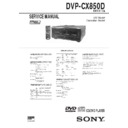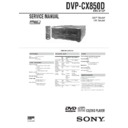Sony DVP-CX850D (serv.man3) Service Manual ▷ View online
DVP-CX850D
RMT-D113A
US Model
Canadian Model
SERVICE MANUAL
SUPPLEMENT-1
File this supplement with the Service Manual.
(99-019)
Subject: Change of the MECHANICAL ADJUSTMENTS
SECTION 7
MECHANICAL ADJUSTMENTS
DVP-CX850D
— 2 —
Adjust the sensor block in the numerical order given.
7-1. TS-150 Board Position Adjustment
7-2. SO-11 Board Position Adjustment
7-3. Disc Sensor Level Adjustment
7-4. Disc/Table Sensor Check
7-5. Holder (Disc A) Adjustment
7-6. Guide (Disc T) Adjustment
7-7. Disc Pully Adjustment and Check
7-8. Magnet Assembly Adjustment
7-1. TS-150 Board Position Adjustment
7-2. SO-11 Board Position Adjustment
7-3. Disc Sensor Level Adjustment
7-4. Disc/Table Sensor Check
7-5. Holder (Disc A) Adjustment
7-6. Guide (Disc T) Adjustment
7-7. Disc Pully Adjustment and Check
7-8. Magnet Assembly Adjustment
[Preparation]
Before adjustments of sections 7-5 to 7-8, perform the following
preparation.
Before adjustments of sections 7-5 to 7-8, perform the following
preparation.
1.
Remove the top cover.
2.
Press TITLE , CLEAR , 6/1 to enter the Test Mode menu.
3.
Enter “## Drive Manual Operation ##” using 2.
4.
Enter “## 200 CHG Mecha Con Menu 1#” using 7.
5.
Open the door and insert the disc to No.1. Close the door and
open the control panel.
open the control panel.
6.
Press G (main unit/remote control).
Note 1:
The cam can be rotated when the shuttle ring (main unit/remote
control) is rotated after preparation is complete.
Pressing
The cam can be rotated when the shuttle ring (main unit/remote
control) is rotated after preparation is complete.
Pressing
J of the cursor puts the machine into the state in which
the cam is rotated fully clockwise. Pressing
j of the cursor puts the
machine into the state in which the cam is rotated fully
counterclockwise.
The table 200 may be rotated by mistake depending on the timing
of pressing
counterclockwise.
The table 200 may be rotated by mistake depending on the timing
of pressing
j. In such a case, press G [main unit/remote control]
to return the table 200 to the original position.
Note 2:
In the case if the main power cannot be supplied, the cam can be
turned by rotating the pully directly with hand.
In the case if the main power cannot be supplied, the cam can be
turned by rotating the pully directly with hand.
7-1. TS-150 BOARD POSITION
ADJUSTMENT
Adjustment Procedure:
1.
1.
Enter the test mode. Select “2. Drive Manual Operation” from
the test menu.
the test menu.
2.
Select “8. 200CHG MechaCon 2” from the operation menu.
3.
Press the PLAY button. Input Disc No. 112. Press the ENTER
button. The chucking operation is completed at the position
of Disc No. 112.
button. The chucking operation is completed at the position
of Disc No. 112.
4.
Move the disc table with hands.
5.
Confirm that the screw that fixes the plate metal of the TS-150
board is positioned in nearly the center of the screw hole.
board is positioned in nearly the center of the screw hole.
6.
Loosen the screw that fixes the plate metal of the TS-150 board.
7.
Observe the T. SENS1 signal a pin-7 of CN704 on the TS-150
board. Make an attempt to move the position of the TS-150
board. Tighten the fixing screw at the position where the
waveform changes when the TS-150 board is moved.
board. Make an attempt to move the position of the TS-150
board. Tighten the fixing screw at the position where the
waveform changes when the TS-150 board is moved.
Fig. 7-3
Direction
Direction
Cam
Pully
Fig. 7-1
Fig. 7-2
— 3 —
7-2. SO-11 BOARD POSITION
ADJUSTMENT
Adjustment Procedure:
1.
1.
Enter the test mode. Select “2. Drive Manual Operation” from
the test menu.
the test menu.
2.
Select “8. 200CHG MechaCon 2” from the operation menu.
3.
Press the
r button to release chucking.
4.
Press the PAUSE button so that the disc table rotates
continuously in the clockwise direction.
continuously in the clockwise direction.
5.
Loosen the screw fixing the SO-11 board.
6.
Turn RV701 on the TS-150 board fully counter-clockwise.
7.
Observe the SI-E signal, T. SENS2 signal and T. SENS3 signal
at pins-2, -4 and -5 of CN704 on TS-150 board. Confirm that
the phase difference between the peak position of the SI-E signal
and the center position of the period when both the T. SENS2
signal and T. SENS3 signal are High, is 2.5 ms or less. If this
specification is not satisfied, adjust the position of the TS-150
board until the above-described specification is satisfied.
at pins-2, -4 and -5 of CN704 on TS-150 board. Confirm that
the phase difference between the peak position of the SI-E signal
and the center position of the period when both the T. SENS2
signal and T. SENS3 signal are High, is 2.5 ms or less. If this
specification is not satisfied, adjust the position of the TS-150
board until the above-described specification is satisfied.
8.
Tighten the screw fixing the SO-11 board.
Fig. 7-4
Fig. 7-5
(Clockwise direction when viewed from the top: turning to the right)
T.SENS2
T.SENS3
SI-E
Peak
Peak
SI-E : Peak = 0
±
2.5 mS
(0 : Center of T.SENS2 = "H" and T.SENS3 = "H")
VH = 3 V (saturated)
SI-E signal at
pin-2/CN704
pin-2/CN704
VL = 1.5
±
0.5 V
RV701
Adjust the position (angle) of the TS-150 board until the top peak
of the SI-E signal (pin-2 of CN704 on TS-150 board) is positioned
at the center of the period when both the T. SENS2 signal and T.
SENS3 signal are High.
of the SI-E signal (pin-2 of CN704 on TS-150 board) is positioned
at the center of the period when both the T. SENS2 signal and T.
SENS3 signal are High.
Fig. 7-6
7-3. DISC SENSOR LEVEL
ADJUSTMENT
Adjustment Procedure:
1.
1.
Enter the test mode. Select “2. Drive Manual Operation” from
the test menu.
the test menu.
2.
Select “8. 200CHG MechaCon 2” from the operation menu.
3.
Press the
r button to release chucking.
4.
Press the PAUSE button so that the disc table rotates
continuously in the clockwise direction.
continuously in the clockwise direction.
5.
Observe the SI-E signal at pins-2, -4 and -5 of CN704 on TS-
150 board. Adjust RV701 on the TS-150 board so that the duty
ratio of the waveform becomes 4:1.
150 board. Adjust RV701 on the TS-150 board so that the duty
ratio of the waveform becomes 4:1.
Fig. 7-7
7-4. DISC/TABLE SENSOR CHECK
Adjustment Procedure:
1.
1.
Enter the test mode. Select “2. Drive Manual Operation” from
the test menu.
the test menu.
2.
Select “8. 200CHG MechaCon 2” from the operation menu.
3.
Remove the disc from the disc table.
4.
Confirm that, when you press the CLEAR button, the Disc
Count indicates 0, and the disc table rotates so that the Disc
No. 2 comes to the front of the door and stops.
Count indicates 0, and the disc table rotates so that the Disc
No. 2 comes to the front of the door and stops.
— 4 —
7-5. HOLDER (DISC A) ADJUSTMENT
Cam
1
Rotate the cam until the cam
comes to the position as
shown in the illustration so
that the cam is aligned.
shown in the illustration so
that the cam is aligned.
Thrust screw
Cam
Disc holder (base)
Disc holder (base)
2
Confirm the position as shown
in the illustration is established.
0–1mm
Disc
Disc
Disc holder (base)
Thrust screw
3
After applying the screw lock to the portion , rotate the thrust screw
so that the disc holder (base) is positioned at the center of the disc.
Screw lock
Display



